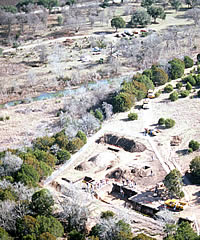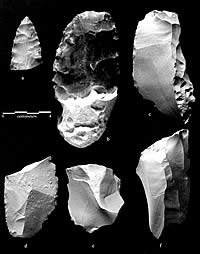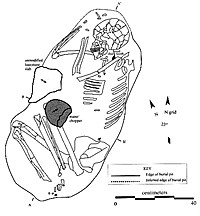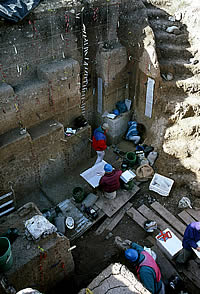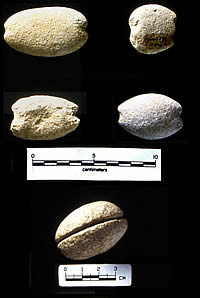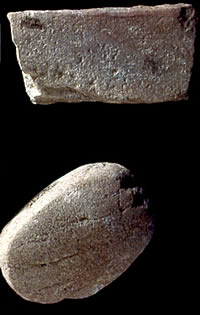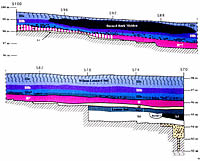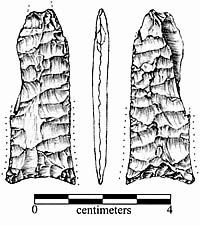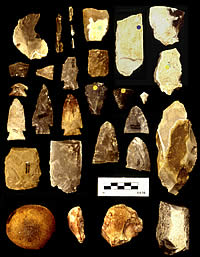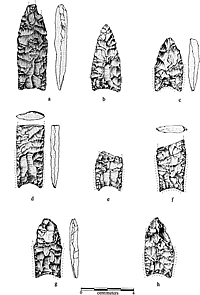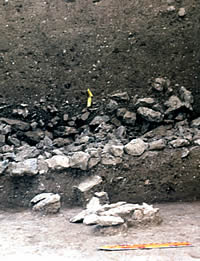Wilson-Leonard Site
This deeply stratified site in the Brushy Creek valley of southwestern Williamson County contains evidence from every prehistoric time period in Texas, the most complete single-site record of its kind for the southern periphery of the Great Plains. The Wilson-Leonard site (41WM235) evidences a succession of ancient peoples—from early Paleoindian Clovis cultures to Late Prehistoric Toyah folk—practiced a hunting and gathering lifeway throughout nearly 13,500 years. For the last 8,500 years of that time, campers at the site also used earth-oven cooking technology to cook bulbs from tuberous plants as well as other foods.
The site was excavated in the early 1980s by the Texas Department of Transportation in advance of construction of Ranch-to-Market Road 1431. Roughly ten years later, archeologists from the Texas Archeological Research Laboratory, led by Michael B. Collins, returned to the site to do further work. Using a host of new technology and research methods, the team gleaned significant new information on human ecology, chronology, and paleoenvironmental changes. Among the more significant findings of the TxDOT/TARL excavations are:
- Recovery of an early human burial, one of the oldest and most complete in North America. The individual—a young female—was somewhere between 18 to 25 years at time of death. She was buried roughly 11,000 years ago (9000 B.C., or 9500 radio carbon years B.P.) in a shallow grave with a worn grinding-chopping tool placed at her side and a large limestone boulder above her, perhaps to hold a hide wrapping. Archeologists nicknamed her Leanne (or the "Leanderthal Lady"), in reference to the nearby town of Leander, Texas. (See Prehistory/Leanne's Burial for more detail.)
- Documentation of a newly identified cultural component—that encompassing the Leanne burial—and including several limestone hearths, pits (possibly for storage or boiling foods with hot stones), and a variety of tools, including grinding stones and Archaic-style, corner notched stemmed projectile points referred to as Wilson. Evidence from the Wilson occupations wedged between two lanceolate point zones more typical of the Paleoindian indicate that the transformation to Archaic subsistence strategies was not a linear process. Different but contemporaneous lifeways were played out in various locations across the south-central U.S. as early Holocene peoples experimented with different technical and social strategies to cope with environmental changes.
- Recovery of possible pre-Clovis evidence (a handful of chipped stone artifacts including modified flakes and a biface, possibly in secondary context) and a probable Clovis component comprising tools with strong Clovis technological affinities and dating to ca. 11,500 B.C.).
- Indications of greater complexity and variability in Paleoindian projectile point styles than previously known. Based on statistical analysis of unfluted lanceolate forms from the site, a new type, St Mary's Hall, was proposed for points previously identified as Plainview.
- Evidence recovered from an enigmatic "Bone Bed" component suggesting that Folsom and Plainview intervals may be more contemporary than sequential. The component appears similar to Folsom in terms of lithic technology (eg., ultra-thin bifaces) and association with bison, but it dated to approximately 11,400 to 11,000 B.C., earlier than Folsom, and contained a single unclassifiable, unfluted projectile point.
- Documentation of a 11,000-year-long sequence of burned rock cooking features (more than 200), beginning with small cooking hearths with a few stones and shifting to larger, more complex hot-rock appliances. By 7,000 B.C., the site saw the development of fully developed earth ovens used for baking a variety of foods including camas (wild hyacinth) bulbs, a likely staple for Early Archaic campers.
- Recovery of a variety of data toward a regional paleoenvironmental sequence (based on physical stratigraphy, macro- and microfauna, diatoms, ostracodes, plant remains and carbon isotopes).
References:
Collins, Michael B. (Assembler and Editor)
1998 Wilson-Leonard: An 11,000-year
Archeological Record of Hunter-Gatherers in Central Texas (five volumes).
Studies in Archeology 31. Texas Archeological Research Laboratory, The University
of Texas at Austin, and Archeology Studies Program Report 10, Texas Department
of Transportation, Environmental Affairs Division.
Collins, M.B., C. B. Bousman, P. Goldberg, P.R. Takac, J.C. Guy, J.L. Lanata,
T.W. Stafford, and V.T. Holliday
1993 The Paleoindian Sequence at the Wilson-Leonard
Site, Texas Current Research in the Pleistocene 10:10-12.
Masson, M.A. and M.B. Collins
1995 The Wilson-Leonard Site (41WM235). Cultural
Resource Management News and Views 7(1):6-10.Texas Historical Commission, Texas.
For more information on the Paleoindian Wilson component, see:
Bousman, C. Britt, Michael B.Collins, Paul Goldberg, Thomas Stafford, Jan
Guy, Barry W. Baker, D. Gentry Steele, Marvin Kay, Ann Kerr, Glen
Fredlund, Phil Dering, Vance Holliday, Diane Wilson, Wulf Gose, Susan
Dial, Paul Takac, Robin Balinsky, Marilyn Masson, and Joseph F. Powell
2002 The
Palaeoindian-Archaic transition in North America: new evidence from Texas. Antiquity 76(2002): 980-90.
